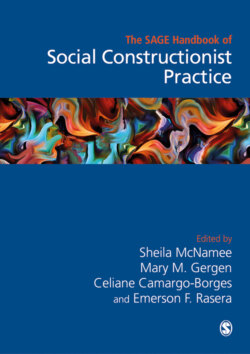Читать книгу The Sage Handbook of Social Constructionist Practice - Группа авторов - Страница 83
На сайте Литреса книга снята с продажи.
Embodied Performance
ОглавлениеThe blend of activism and performance has a long history in the culture of protest. The Brazilian theater practitioner and political activist, Augusto Boal (1995), is noteworthy in opening the way to blending embodied performance with social theory, and he has inspired many to follow. For example, Jonathan Shailor in his work in prisons uses performative methods to create change in the lives of inmates (2010). Also illustrative is the theatrical work of Anna Deavere Smith on youth going to prison (2019), Mary Gergen on women and aging (2001), and Anita Woodley (2015), an inspiring storyteller and creator of ethnodramas, in her role as Mama Juggs on breast cancer and body image. Tami Spry, who has a special concern with Native American lives, also offers wisdom and guidance to those who may be drawn to the potentials of performance (2001, 2011). A major innovator in performance studies is the East Side Institute in New York City, where dramatic productions are integral to educational, therapeutic and community-building functions (Holzman, 1999; Newman, 1996). From this perspective, the performative nature of human relationships is implicated in their doing, and thus, a performative analysis is coherent with the drama of everyday life.
However, there is also increasing movement toward full-blown performance. For example, Johnny Saldaña, an educator and musician, has transformed an aspect of his life story into an hour-long theatrical piece, ‘Second Chair’, during which he plays music as well as speaks lines (Saldaña, 2011). Organizational behavior scholar, Frank Barrett, a former professional jazz musician, has developed a brilliant musical presentation involving audience participation, to illustrate the creation of meaning through collaboration (2012).
Possibly because of the far greater demands involved (e.g. multiple performers, costumes, sets) the deployment of theatrical plays as social inquiry has not been well developed. One of the most salutary inspirations is the work of Gray and Sinding (2002), in which women with metastasized breast cancer both wrote and performed a play inviting others, especially medical personnel, to treat them as whole persons, in contrast to reducing their identities to their diseases. Park (2009) and Norris (2010) have shown how play building can be used as a form of action research. As mentioned, Kip Jones has been at the forefront of this effort to use film as a form of performative inquiry (Hearing and Jones, 2018).
